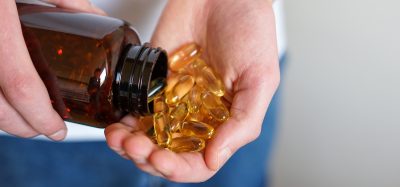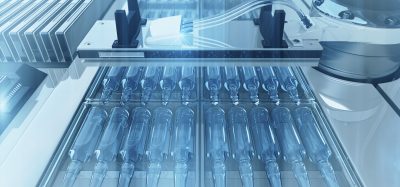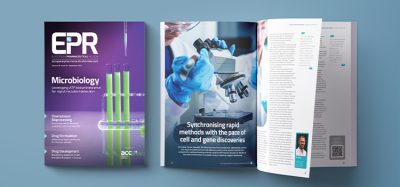A “PAT” on the back for Rapid Microbiological Methods
The modern microbiological laboratory needs to change and become more innovative in its approach to microbial detection, enumeration and identification.
The modern microbiological laboratory needs to change and become more innovative in its approach to microbial detection, enumeration and identification.
The modern microbiological laboratory needs to change and become more innovative in its approach to microbial detection, enumeration and identification.
Why?
The pharmaceutical industry, in line with regulatory expectations, has the opportunity to embrace current initiatives and philosophies for drug development, manufacture and supply, e.g. Food and Drug Administration (FDA) GMPs for the 21st Century- A Risk-based approach, Process Analytical Technologies (PAT), ICH Q8, Q9, Q10 guidelines on Pharmaceutical Development, Quality Risk Based management and Pharmaceutical Quality systems respectively.
So what does this mean?
If innovative microbiological methods of analysis are linked into current manufacturing trends they will help provide better process understanding which leads to greater process control (less waste, less rework etc) and reduced risk because quality is built into the product and process, rather than being tested in.
So the benefits to using alternative or rapid microbiological methods (RMMs) may include:
- Greater patient safety.
- Timely data that may be significantly better than that provided by traditional methods.
- More cost effective.
- Provide marketing advantages.
- Reduce regulatory oversight (reduced inspections, faster approvals etc).
The RMM technology is now available, or close to being available, which will speed up microbiological analysis and allow the pharmaceutical industry to embrace the concepts of PAT and risk based approach to pharmaceutical processing.
While science has moved on and developed RMMs, the pharmaceutical industry has been slow to adopt the technologies and implement them.
Technology and validation
Many pharmaceutical companies fear that they cannot demonstrate that RMMs are equivalent or better than the systems / methodologies they currently employ. They also are concerned that insufficient guidance is available on how to validate a new method or laboratory system.
In recent years, a variety of guidance documents have been issued or drafted to support the selection, validation, implementation and even regulatory approval of RMMs, e.g.:
- The Parenteral Drug Association (PDA) technical report (TR-33), “Evaluation, Validation and implementation of new microbiological testing methods”, was developed by individuals from industry, regulatory agencies, compendial groups, and the technology suppliers. It provided definitions in microbiological terms for validation criteria as defined in USP chapter <1225> for chemical analytical method validation.
- USP Chapter <1223>, “Validation of alternative microbiological methods”(DRAFT), is a proposed compendial monograph that outlines and defines the validation criteria to be used for RMMs. It also explains which criteria are applicable to different systems, based upon the type of testing to be performed.
- European Pharmacopiea (EP) Chapter 5.1.6, “Alternative methods of control for microbiological quality”, provides an overview of the RMM systems available for pharmaceutical applications (i.e. product and process control). It also provides guidance on selection and validation of the appropriate technology.
So guidance on validation and demonstrating equivalency is available! However demonstrating equivalency of the new technology is only one part of the implementation strategy. Due diligence, from a technical and business perspective must be applied to ensure selection of the correct system, that is fit for purpose. The following should be considered as a minimum:
- Compatibility of the technology with the product or process i.e. do not try to fit a RMM technology to the situation. The product or process must define the selected RMM system.
- Understand the sensitivity and specificity required i.e. level of detection and types of micro-organism to be detected.
- Level of training and qualification required
- Level of support from the supplier e.g. initial assessment, validation, ongoing routine service etc.
Return on Investment (ROI)
Capital investment for RMMs can be significant and ongoing testing costs can also be higher than those currently in use for established methodologies. In addition selection, implementation and validation costs also need to be considered. For e.g.:
- Feasibility studies
- User requirement specification (URS) development
- Test protocols / SOPs
- Training
- Validation programme
- Regulatory submission
- Technology transfer
It is therefore recommended that when developing a business case for the introduction of RMMs that a financial advisor is included within the project team. Some benefits that may have financial implications include:
- Reduction in time to result (cycle time) thus allowing for a more rapid product release.
- Lean laboratory initiatives through automation, minaturisation, high-throughput etc.
- Increased sensitivity, accuracy, precision etc e.g. single cell detection, stressed organism recovery etcLower inventories (raw materials, finished products etc).
- Reduction in repeat testing, deviations, out of specification (OOS) results etc.
- Well positioned financial benefits will provide a strong business case and facilitate management buy-in to RMMs.
Regulatory concerns
Some pharmaceutical companies perceive regulatory uncertainty as a barrier to the introduction of RMMs for a number of reasons:
- Regulators may not recognise the systems as superior to traditional methods.
- Increased sensitivity may require changes to microbial limits.
- Acceptability of a particular technology for a specific application.
- Concerns over providing a suitable validation and regulatory submission strategy.
PAT is a key driver for both the European and US regulatory bodies to encourage building quality into product and processes. In reality there is no regulatory body barrier to adopting RMMs and it is actively encouraged to open a dialogue with the appropriate regulatory body to establish the approach and application of RMMs.
So what does this mean in terms of microbiological in-process control?
There are many opportunities for implementing RMMs in the pharmaceutical industry for both aseptic and terminally sterilised products. For example, the following list identifies those highlighted as potential areas of application for RMMs:
- Procurement of ingredients
- Warehousing ingredients
- Incoming testing of ingredients
- Batching of ingredients
- Preparation of water for injection
- Bulk solution equipment cleaning
- Bulk solution preparation and release
- Container and closure preparation, depyrogenisation, and sterilisation
- Aseptic filling equipment sterilisation
- Clean room sanitisation
- Personnel gowning and entry
- Sterile filtration
- Aseptic filling, capping and sealing
- Air, personnel, and facilities monitoring
- Product inspection
- Quality attributes testing
- Batch record review
- Product release
So can RMMs provide real or near real time data at, in or on-line?
RMM technologies
Current technologies are based upon “is something there” i.e. presence or absence of micro-organisms, “how much is there” i.e. number of micro-organisms” and “what is there” i.e. identification.
RMMs methods are based upon how the technology operates i.e. growth of micro-organisms, viability of micro-organisms, presence / absence of cellular components, nucleic acid methods, traditional methods combined with computer aided imaging and combination methods.
Growth based technologies
These technologies are based upon measurement of biochemical or physiological parameters that reflect the growth of micro-organisms. These all require organisms to proliferate in a test sample.
Examples of these systems include:
- ATP- BioluminescenceMilliflex rapid system (Millipore), Rapiscreen (Celsis), Pallcheck (Pall systems). These systems depend upon the ATP present in the microbial cell. When released in the presence of the substrate D-luciferin, oxygen and magnesium ions, the enzyme Luciferase will produce light which is measured by a luminometer.
- Impedance systems – Bactometer (Biomerieux), RABIT(Don Whitley), Malthus (Malthus instruments). These systems can be direct or indirect, but the basis of detection is measuring changes in electrical conductivity in the growth medium as microbial growth occurs.
- Growth direct (Genomic profiling systems) – Based upon microbial growth on agar with computer assisted CCD camera technology for visualisation.
- Changes in head space pressure – e.g. BacT/Alert (Biomerieux). These systems use electronic transducers that measure positive or negative pressure changes in the head space of each culture bottle.
Other growth based systems for rapid microbial detection involve the measurement of Adenylate Kinase, Conductivity and Tubibity.
These growth based systems can be quantitative or qualitative, applied to a variety of tests e.g. raw materials, finished products, in-process samples, pharmaceutical grade waters, environmental monitoring etc. Principally used for non-sterile samples, but e.g. BacT/Alert is approved in supporting the sterility test and early product release in one application. ATP systems have been approved in both Europe and the USA for finished product testing, and for pharmaceutical grade water testing. Depending on the technology, time to detection can circa 8-48 hours.
Viability based technologies
These technologies utilise viability stains or cellular markers to enumerate micro-organisms, without the need for cellular growth. Such systems include:
- Direct Epifluorescent Filter Technique (DEFT) – Samples are filtered and stained with a fluorescent viability indicator..
- Flow Cytometry – Chemflow (AES/Chemunex), RBD3000 (AATI-US). Micro-organisms within a sample are labelled with a viability marker. Within the cell the marker is cleaved to release a fluorescent substrate. The cells are passed through a quartz flow cell monitored by a LASER.
- Solid Phase Cytometry – ChemScan (AES/Chemunex). Like the Flow cytometry above, detection is through the LASER excitation and ultimate measurement of the fluorescent viability marker. The difference is that samples are filtered and the LASER scans the surface of the membrane looking for fluorescent particles.
Identification technologies
The systems discussed above are directed towards the enumeration of micro-organisms within a given sample. However, the type of organism may also be required and hence rapid identification systems are available. These can be divided into two broad categories, namely Phenotypic or Genotypic systems.
Phenotypic systems
Like the growth based systems, phenotypic identification technologies rely upon micro-organism growth and substrate utilisation to provide a growth pattern. That is, depending upon which substrates are utilised a profile is obtained that can be compared to a database to provide an identification. Such systems include:
- Vitek systems (Biomerieux)
- Biolog / Omnilog (Haywards)
Genotypic systems
These genetic based technologies rely upon, Polymerase Chain Reaction (PCR) DNA amplification, 16s rRNA typing, gene sequencing or other novel applications. The identification results from comparing the gene sequence or gene fingerprint of a given micro-organism to that on a database. These systems provide results in 4-8 hours and can handle (depending on the system) 32-96 samples per run. Such systems include:
- Riboprinter (Dupont, Qualicon)
- Microseq (Applied Biosystems)
- MassArray (Sequrnom)
- Bacterial Barcodes (Diversilab systems)
- Ibis (PCR mass spectrometry TIGER system) (Carlsbad)
Other rapid identification systems include the Sherlock microbial identification system (MIDI inc) which is based upon gas chromatography of microbial cell wall fatty acid profiles. There is a trend to link the results of the Sherlock system with gene sequencing to provide a definitive identification. The Sherlock can process up to 75 samples per day.
Future technologies
The above technologies provide considerable advantages in terms of speed to result and sensitivity but they are still not “real time”.
However, a number of cutting edge systems are becoming available. These much smaller technology platforms will have an impact on the way microbiological analysis is performed. Some systems offer continuous and instantaneous microbial detection. This makes them applicable to PAT providing at, on or in-line microbiological data e.g.
- Lab on a Chip (LOC) – A miniature microbiological laboratory on a silicon chip. Based upon microfluidic technology, minute amounts of liquid are moved by pressure or voltage changes through channels enabling sample handling, mixing, dilution, separation, staining, detection etc.
- Micro impedance based detection system (BioVitesse) can visualise microbial growth in a miniaturised impedance system.
- Biochips – Collection of tiny test sites on glass, silicon or plastic surfaces allowing several analyses at the same time. Fragments of protein, DNA, RNA etc are organised on a single chip and then “probed” and visualised using fluorescent tags.
- Biosensors – Typically, immunological reagents are combined with sensor detection systems to produce an immunosensor for the detection of microbial pathogens. Sensors can contain micro-organisms, organelles, cell receptor enzymes, nucleic acids, antibodies etc. Detection systems can be electrochemical, piezoelectric, thermometric, optical etc.
- Combination systems – This is where miniaturised platform technologies are combined to produce a superior to that of either system alone. For example; ST Microelectronics (Switzerland) has developed breakthrough PCR DNA amplification which can be used for disease / pathogen detection and diagnostics. The technology is based upon Micro-Electro-Mechanical systems and can allow for a portable microbiological laboratory.
- Optical Spectroscopy – Important for detecting particles. It utilises the ability of particles to scatter light. Examples are instantaneous microbial detection systems (IMD-A, IMD-L) from BioVigilant. These instruments can instantaneously and continuously detect microbial contamination in air and liquids.
A number of new technologies / concepts in development will move microbiological analysis into the 21st Century. The examples of current and “in-development” RMM technologies discussed above is not exhaustive but meant to give a flavour of what is available.
How can the current and future RMM technologies be applied to PAT?
This links into a risk based approach to pharmaceutical products and processing. In essence, the following process should be considered:
- Prepare a flow diagram of the manufacturing process under consideration (from raw materials to finished product).
- Examine each step in the process and consider the microbiological risk it represents. (use risk management tools e.g. HACCP, FMEA etc as defined in ICH Q9).
- For each risk identified consider whether it can be removed or reduced to an acceptable level.
- Consider the advantages of RMMs to the remaining risk areas. But make sure the RMM result builds quality into the system e.g. a fast bioburden result may prevent adding value at the next step, but it may be more effective if the cause of the bioburden was controlled.
- Select an RMM which is applicable to the situation (the situation determines the RMM technology and not vice versa).
Having chosen the technology, some level of regulatory approval will be required. In the USA, RMM implementation can gain approval through the use of a comparability protocol within the PAT initiative. A comparability protocol is in effect a written agreement between a company and the FDA to validate and implement a new procedure. If approved the FDA will accept the changes if the acceptance criteria are met. Implementation can then proceed relatively quickly.
In Europe, implementation of RMM is considered a type II variation, which may require a pharmaceutical expert report, formal assessment and a formal pre-approval letter prior to RMM introduction. This may extend the time t o approval.
Together RMM and PAT:
- Offer a mechanism to facilitate regulatory approval of RMM systems (especially in the USA).
- Provide greater patient safety.
- Improve manufacturing cycle times.
- Help build process understanding and quality into pharmaceutical operations.
References
Singer, D.C and Cundell, A.M (2003). The role of rapid microbiological methods within the Process Analytical Technology initiative. Pharm. Forum 29 (6), 2109-2113.
Korczynski, M.S (2004). The Integration of process Analytical Technologies, Concurrent Validation, and Parametric Release Programs in Aseptic Processing. PDA J. Sci. Tech. 58 (4), 181-191.
Newby, P. et al. (2004). The Introduction of Qualitative Rapid Microbiological Methods for Drug-Product Testing. Pharm. Technol. PAT issue 6-12pp.
Green, S.I. (2006) S6 Process Analytical Technologies (PAT): A Microbiological Perspective. Industrial Pharmaceutical Microbiology Supplement 6, S6.1-S6.8pp.
Parenteral Drug Association (2000) Technical report 33, Evaluation, validation and implementation of new microbiological testing methods. J. Pharm. Sci. Technol. 54(3), Suppl TR33.
USP Chapter <1223> (Draft) (2003) Validation of alternative microbiological methods. Pharmacopeial forum, vol 29(1), 256-264 pp.
FDA (2004), “Pharmaceutical cGMPs for the 21st Century- A risk based approach”
FDA (2004) Guidance for industry- PAT a framework for innovative pharmaceutical development, manufacture and quality assurance.
Kricka, L. J. (2003), “New technologies for microbiological assays” in Rapid Microbiological Methods in the pharmaceutical industry, ed M.C.Easter, interpharm / CRC press, 233-248pp.
Robert Johnson
Robert is a director of an independent pharmaceutical consultancy called Dialogue.
He has worked internationally in the pharmaceutical industry for 25 years in both proprietary and generic companies.
Robert is a microbiologist by education and has Qualified Person status. He also serves on the British Pharmacopieal Microbiology and Biotechnology committees.
Robert has experience with pharmaceuticals, medical devices and consumer healthcare products. He has been exposed to all pharmaceutical dosage forms, both sterile and non sterile. He also has a background in active pharmaceutical ingredients.
He has held various positions in research and development, manufacturing and quality operations.
Roberts expertise covers a wide range areas within the industry e.g. facility design, manufacturing operations, quality operations, regulatory submissions etc. He also has a background in six sigma, SPC and process analytical technologies.







